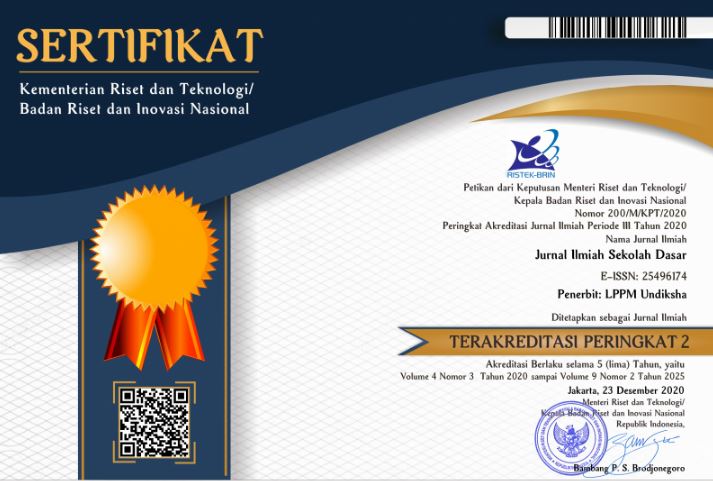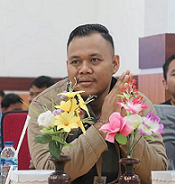Learn Energy Sources with Interactive Learning Multimedia
DOI:
https://doi.org/10.23887/jisd.v5i1.35000Keywords:
Source energy, multimedia interactiveAbstract
The low learning motivation of students is caused by the use of learning media, especially in science learning which is still not optimal. This study aims to create interactive multimedia-based learning media on the topic of energy sources for grade IV elementary schools. This research is development research using the ADDIE model. In this study, the implementation and evaluation stages were not carried out due to time constraints and the current condition of the COVID-19 pandemic. The subject of this research is interactive multimedia-based learning media which is assessed by 2 material experts, 2 media experts, 2 design experts, and 2 practitioner experts as well as individual testing by 3 students and small group testing by 6 students. and the object of this research is the validity of interactive multimedia-based learning media. The data collection method used in this research is the questionnaire method. The data analysis technique used in this research is descriptive qualitative and quantitative analysis. The results showed that the media quality of 1) material experts were at a value of 94.63% (very good). 2) Media experts are at a score of 93.33% (very good). 3) design expert is at 91.66% (very good). 4) Expert Practitioners are at a score of 91.66% (very good). 5) individual trials are at a value of 96.11% (very good). 6) The small group trial was at a value of 94.77% (very good). So the interactive multimedia-based learning media produced are very well qualified and worthy to be used in the teaching and learning process.
References
Abdulrahaman, M. D., Faruk, N., Oloyede, A. A., Surajudeen-Bakinde, N. T., Olawoyin, L. A., Mejabi, O. V., Imam-Fulani, Y. O., Fahm, A. O., & Azeez, A. L. (2020). Multimedia tools in the teaching and learning processes: A systematic review. Heliyon, 6(11), e05312. https://doi.org/10.1016/j.heliyon.2020.e05312
Akbar, N. S. (2016). Pengembangan Multimedia Pembelajaran Energi Alternatif. E-Jurnal Prodi Teknologi Pendidikan, V(6), 109–117. http://journal.student.uny.ac.id/ojs/index.php/fiptp/article/view/3092/2788.
Ariantini, N. K. A., Rati, N. W., & I Nyoman Murda. (2017). Pengaruh model pembelajaran think pair share terhadap hasil belajar ipa siswa kelas v sd gugus ii kecamatan melaya. E-Journal PGSD Universitas Pendidikan Ganesha, 5(2), 1–10. http://dx.doi.org/10.23887/jjpgsd.v5i2.10906.
Fanny, A. M., & Suardiman, S. P. (2013). Pengembangan Multimedia Interaktif Untuk Mata Pelajaran Ilmu Pengetahuan Sosial (Ips) Sekolah Dasar Kelas V. Jurnal Prima Edukasia, 1(1), 1. https://doi.org/10.21831/jpe.v1i1.2311.
Fuadi, Sumaryanto, T., & Lestari, W. (2015). Pengembangan Instrumen Penilaian Aspek Psikomotor Pembelajaran Ipa Materi Tumbuhan Hijau Kelas V Berbasis Kompetensi Pendekatan Sea Berwawasan Konservasi. Journal of Research and Educational Research Evaluation, 4(1), 53–63. https://doi.org/10.15294/jere.
Gallagher, C. (2019). The use of a multimedia case to prepare classroom teachers of emergent bilinguals. Teaching and Teacher Education, 84, 17–29. https://doi.org/10.1016/j.tate.2019.04.011.
Handhika, J. (2012). Efektivitas media pembelajaran im3 ditinjau dari motivasi belajar. Jurnal Pendidikan IPA Indonesia, 1(2), 109–114. https://doi.org/10.15294/jpii.v1i2.2127.
Hernaningtyas, I. S., Susetyarini, R. E., & Widodo, R. (2016). Pengembangan Multimedia Interaktif Ceria (Mic) Pembelajaran Tematik Di Sekolah Dasar. Jurnal Pemikiran Dan Pengembangan Sekolah Dasar (JP2SD), 1(4), 256. https://doi.org/10.22219/jp2sd.vol1.no4.256-266.
Huang, S. Y., Kuo, Y. H., & Chen, H. C. (2020). Applying digital escape rooms infused with science teaching in elementary school: Learning performance, learning motivation, and problem-solving ability. Thinking Skills and Creativity, 37(April), 100681. https://doi.org/10.1016/j.tsc.2020.100681.
Irfan, I., Muhiddin, M., & Ristiana, E. (2019). Pengembangan Media Pembelajaran IPA Berbasis Powerpoint di Sekolah Dasar. Indonesian Journal of Primary …, 3(2), 16–27. https://ejournal.upi.edu/index.php/IJPE/article/view/21765.
Khan, F. M. A., & Masood, M. (2015). The Effectiveness of an Interactive Multimedia Courseware with Cooperative Mastery Approach in Enhancing Higher Order Thinking Skills in Learning Cellular Respiration. Procedia - Social and Behavioral Sciences, 176, 977–984. https://doi.org/10.1016/j.sbspro.2015.01.567.
Kornmann, J., Kammerer, Y., Zettler, I., Trautwein, U., & Gerjets, P. (2016). Hypermedia exploration stimulates multiperspective reasoning in elementary school children with high working memory capacity: A tablet computer study. Learning and Individual Differences, 51, 273–283. https://doi.org/10.1016/j.lindif.2016.08.041.
Laksana, D. N. L. (2016). Miskonsepsi Dalam Materi Ipa Sekolah Dasar. JPI (Jurnal Pendidikan Indonesia), 5(2), 166. https://doi.org/10.23887/jpi-undiksha.v5i2.8588.
Lee, T. T., & Osman, K. (2012). Interactive Multimedia Module in the Learning of Electrochemistry: Effects on Students’ Understanding and Motivation. Procedia - Social and Behavioral Sciences, 46, 1323–1327. https://doi.org/10.1016/j.sbspro.2012.05.295.
Lewis, A. D. (2019). Practice what you teach: How experiencing elementary school science teaching practices helps prepare teacher candidates. Teaching and Teacher Education, 86, 102886. https://doi.org/10.1016/j.tate.2019.102886.
Paratore, J. R., O’Brien, L. M., Jiménez, L., Salinas, A., & Ly, C. (2016). Engaging preservice teachers in integrated study and use of educational media and technology in teaching reading. Teaching and Teacher Education, 59, 247–260. https://doi.org/10.1016/j.tate.2016.06.003.
Pariartha, I. G. M. A., Parmiti, D. P., & Sudatha, I. G. W. (2013). Pengembangan Media Pembelajaran Berbasis Multimedia Interaktif Pada Mata Pelajaran Ipa Untuk Siswa Kelas Viii Semester 1 Di Smp Negeri 3 Singaraja Tahun Pelajaran 2012/2013. Jurnal EDUTECH Undiksha, 1(2). http://dx.doi.org/10.23887/jeu.v1i2.938.
Prabawa, D. G. A. P., & Restami, M. P. (2020). Pengembangan Multimedia Tematik Berpendekatan Saintifik untuk Siswa Sekolah Dasar. Mimbar PGSD Undikhsa, 8(3), 479–491. https://ejournal.undiksha.ac.id/index.php/JJPGSD%0APengembangan.
Pujiastuti, D., Idrus, A., & Emosda. (2014). Pengembangan Media Pembelajaran Pkn Berbasis Multimedia Interaktif Untuk SMP Kelas VIII. Tekno-Pedagogi, 4(1), 1–6. https://online-journal.unja.ac.id/pedagogi/article/view/2245.
Purnamasari, S., & Herman, T. (2017). Penggunaan Multimedia Interaktif Terhadap Peningkatan Kemampuan Pemahaman Dan Komunikasi Matematis, Serta Kemandirian Belajar Siswa Sekolah Dasar. EduHumaniora | Jurnal Pendidikan Dasar Kampus Cibiru, 8(2), 178. https://doi.org/10.17509/eh.v8i2.5140.
Putri, S. U. (2015). Penerapan pendekatan. Metodik Didaktik, 10(1), 69–77. https://doi.org/10.17509/md.v10i1.3231.
Rahayu, P., Mulyani, S., & Miswadi, S. S. (2012). Pengembangan pembelajaran IPA terpadu dengan menggunakan model pembelajaran problem base melalui lesson study. Jurnal Pendidikan IPA Indonesia, 1(1), 63–70. https://doi.org/10.15294/jpii.v1i1.2015.
Rante, P., Sudarto, & Ihsan, N. (2013). Pengembangan multimedia pembelajaran fisika berbasis audio-video eksperimen listrik dinamis di smp. Jurnal Pendidikan IPA Indonesia, 2(2), 203–208. https://doi.org/10.15294/jpii.v2i2.2724.
Riani, S., Hindun, I., & Krisno Budiyanto, M. A. (2015). Pengembangan Media Pembelajaran Berbasis Multimedia Interaktif Untuk Meningkatkan Pemahaman Materi Bioteknologi Modern Siswa Kelas Xii Sma. Jurnal Pendidikan Biologi Indonesia, 1(1), 9–16. https://doi.org/10.22219/jpbi.v1i1.2298.
Saifudin, M. F., Susilaningsih, & Wedi, A. (2020). Pengembangan multimedia interaktif materi sumber energi untuk memudahkan belajar siswa sd. Jurnal Kajian Teknologi Pendidikan, 3(1), 68–77. https://core.ac.uk/download/pdf/287323706.pdf.
Savira, F., & Suharsono, Y. (2013). Pengaruh Penggunaan Media Pembelajaran Terhadap Hasil Belajar Siswa Pada Mata Pelajaran Ekonomi Di Sma. Journal of Chemical Information and Modeling, 01(01), 1689–1699.
Sofyan, R., WS, R., & Ghullam Hamdu. (2016). Thematic learning media development based interactive multimedia. 272–280. https://ejournal.upi.edu/index.php/pedadidaktika/article/view/5157
Ucus, S. (2015). Elementary School Teachers’ Views on Game-based Learning as a Teaching Method. Procedia - Social and Behavioral Sciences, 186, 401–409. https://doi.org/10.1016/j.sbspro.2015.04.216.
Widayat, W., Kasmui, & Sukaesih, S. (2014). Pengembangan Multimedia Interaktif Sebagai Media Pembelajaran Ipa Terpadu Pada Tema Sistem Gerak Pada Manusia. USEJ - Unnes Science Education Journal, 3(2), 535–541. https://doi.org/10.15294/usej.v3i2.3353.
Wulandari, R., Susilo, H., & Kuswandi, D. (2017). Penggunaan multimedia interaktif bermuatan game edukasi untuk siswa sekolah dasar. Jurnal Pendidikan: Teori , Penelitian Dan Pengembangan, 2(8), 1024–1029. http://journal.um.ac.id/index.php/jptpp/article/view/9759/4611.
Yakovleva, Y. V., & Goltsova, N. V. (2016). Information and Communication Technologies as a Means of Developing Pupils’ Learning Motivation in Elementary School. Procedia - Social and Behavioral Sciences, 233(May), 428–432. https://doi.org/10.1016/j.sbspro.2016.10.179.
Downloads
Published
How to Cite
Issue
Section
License
Authors who publish with the Journal Ilmiah Sekolah Dasar agree to the following terms:
- Authors retain copyright and grant the journal the right of first publication with the work simultaneously licensed under a Creative Commons Attribution License (CC BY-SA 4.0) that allows others to share the work with an acknowledgment of the work's authorship and initial publication in this journal.
- Authors are able to enter into separate, additional contractual arrangements for the non-exclusive distribution of the journal's published version of the work (e.g., post it to an institutional repository or publish it in a book), with an acknowledgment of its initial publication in this journal.
- Authors are permitted and encouraged to post their work online (e.g., in institutional repositories or on their website) prior to and during the submission process, as it can lead to productive exchanges, as well as earlier and greater citation of published work. (See The Effect of Open Access)










